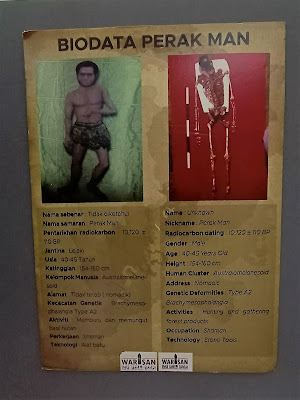“In the long run, the sharpest weapon of all is a kind and gentle spirit.” - Anne Frank
 |
| (A sketch of the Perak Man) |
When we were in Addis Ababa in 2013 we visited the National Museum of Ethiopia and had the opportunity to view the remains of the first oldest homenid found, Lucy.
 |
| (2013 - Lucy in Ethiopian National Museum) |
Today we are going to explore Lenggong Valley where Perak Man, the oldest of human skeletons ever found in Malaysia and Asia.
Our first visit was the Lenggong Valley Archaeological Gallery. Unfortunately it was still closed for renovation. We were redirected to a temporary museum managed by USM situated a short distance away and met with En. Rosli, one of the team pioneering the excavation of Lenggong Valley leading to the findings of the remains of Perak Man.
 |
| (A colourful signage) |
 |
| (Taking the junction to the gallery) |
 |
| (One will not miss these landmarks) |
The Lenggong Valley contains evidence in open-air and cave sites along the Perak River spanning all the periods of hominid history outside Africa from 1.83 million to 1,700 years ago. The skeleton of Perak Man was found in 1991 in the Gua Gunung Runtuh located at Bukit Kepala Gajah, in the Lenggong Valley, Hulu Perak.
 |
| (A newly renovated building) |
 |
| (Thè gallery is closed!) |
 |
| (Will visit again next time) |
This finding is the result of research conducted by the Malaysian Archaeological Research Center USM in collaboration with the Department of Museums Malaysia. Among the findings is the skeleton of the Perak Man which is between 10,000-11,000 years old.
 |
| (En. Rosli, a learned friendly guide) |
 |
| (An important archaeological site) |
 |
| (Excavation site of Perak Man) |
Perak Man is an almost perfect human skeletons from the stone age of the Palaeolithic era found in Southeast Asia and is a prehistoric bone that has a congenital deformity known as Brchymesophalangia. Perak Man was buried in a “foetal” position, i.e. both his legs were folded towards his chest with his hands holding some meats. It was buried with some stone utensils and thousands of shells from the river.
Note:
June 14,2023 GUA MUSANG: A human skeleton has been found in the foetal position along with several artefacts during excavations at Gua Keledung Kecil in the Nenggiri Valley in Kelantan.
It shows that the Nenggiri area was inhabited 14,000 years ago, making the site older than where the Perak man was previously found... - Berita Harian

























No comments:
Post a Comment